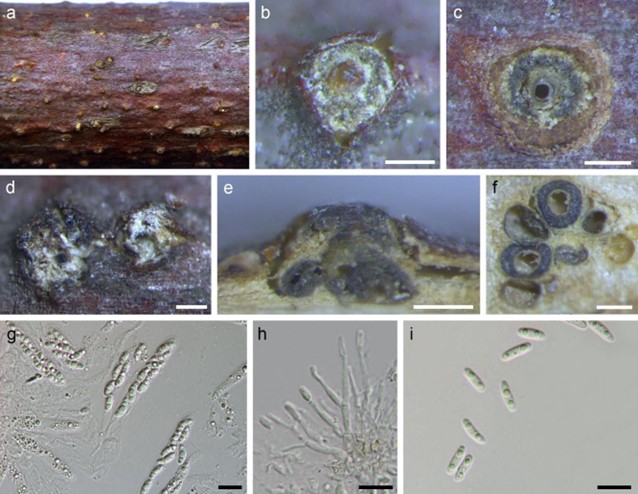Diaporthosporella C.M. Tian & Q. Yang; Mycoscience 59: 229–235 (2017)
MycoBank number: MB 822664; Index Fungorum number: IF 822664; Facesoffungi number: FoF 08398; 1 species with sequence data.
Type species – Diaporthosporella cercidicola C.M. Tian & Q. Yang
Notes – Diaporthosporella was introduced by Yang et al. (2018d). Diaporthosporella cercidicola is characterized by hyaline, allantoid or sub-reniform, aseptate ascospores and acropleurogenous, branched or sympodially branched conidiophores, producing hyaline, ellipsoidal, aseptate and biguttulate conidia (Yang et al. 2018d). Diaporthosporella comprises a single species found on branches and twigs of Cercis chinensis in China (Yang et al. 2018d). Diaporthosporella cercidicola is similar to Diaporthe eres Nitschke in having unitunicate, clavate asci, hyaline, guttulate ascospores, but can be separated by phylogeny (Yang et al. 2018d). The asexual morph produces a yellowish conidial mass and aseptate, hyaline conidia, characters that are common to both Diaporthosporella cercidicola and Diaporthe eres (Udayanga et al. 2014, Yang et al. 2018d). Diaporthosporella cercidicola is closely related to Juglanconidaceae according to molecular phylogeny (Voglmayr et al. 2017).

Figure 95 – Diaporthosporella cercidicola (Material examined – CHINA, Jiangsu Province, Nanjing City, Xuanwu lake scenic area, on twigs and branches of Cercis chinensis, 11 Nov. 2015, Yang, BJFC-S1356, holotype). a Appearance on host. b-d Stromata on host. e Vertical section through stroma. f Horizontal section through stroma. g Asci with ascospores and and paraphyses. h Conidiophores with conidia. i Conidia. Scale bars: b-f = 200 µm, g-i = 10 µm.
